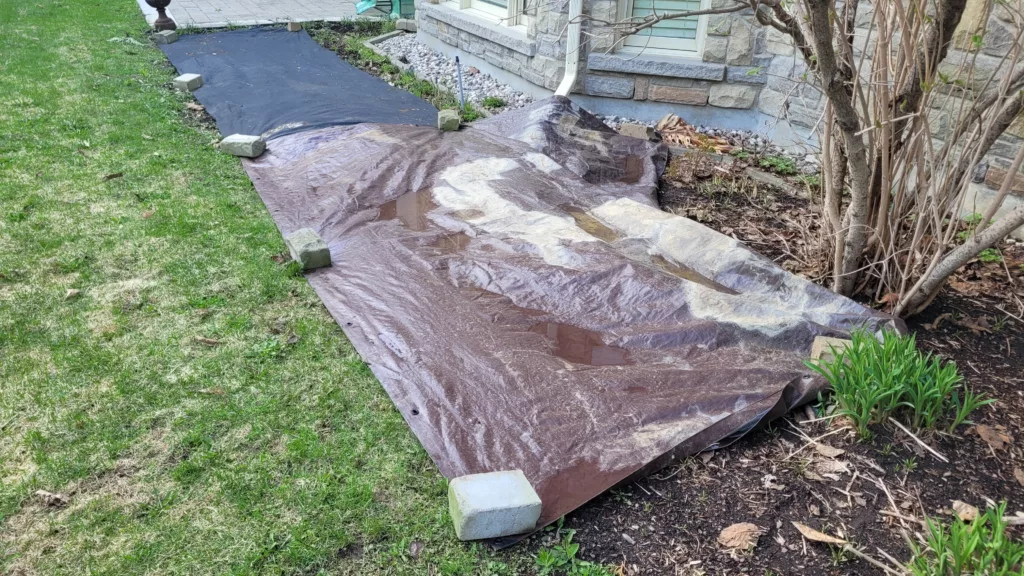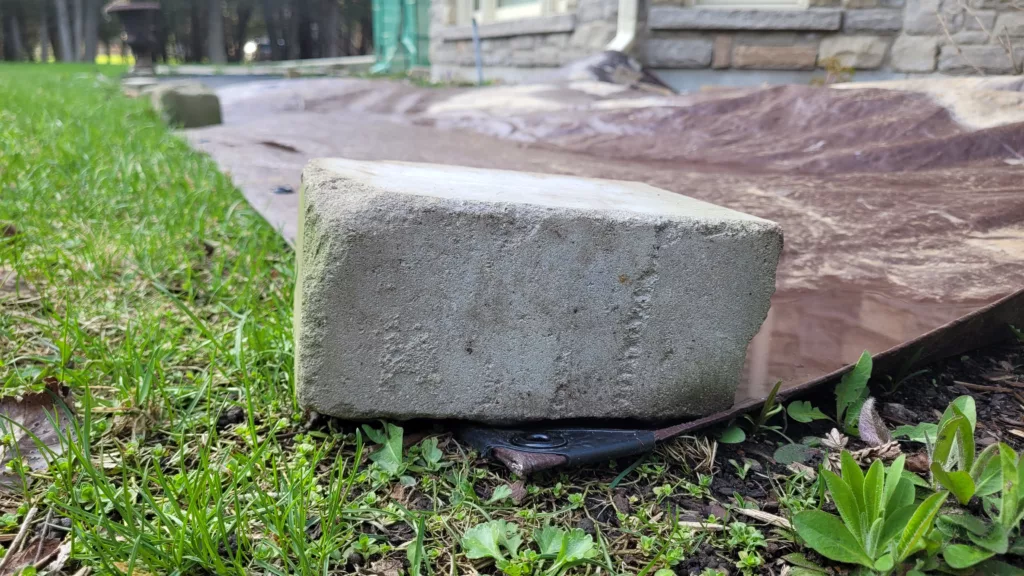This post may contain affiliate links. If you use these links to buy something we may earn a commission. Thanks.
If you’re looking to use tarps to get rid of weeds you’ll either be performing solarization or occultation and the best choice depends on what you need to accomplish.
When I heard about solarizing soil, I went and did it thinking I actually tried it on my garden. But after diving into some research, I learned I used the ‘occultation’ method.

Now that you’ve heard about both, you’ll be wondering about the difference between the two, as I did.
Solarization uses a transparent tarp and occultation uses a black tarp and as a result, the speed at which weeds are terminated is the primary difference. When light is allowed through, the soil itself heats fast while a black tarp absorbs heat before the soil feels significant temperatures.
Today, I use both techniques, but at different times of the year to keep non-backbreaking weed-free gardens.
- We used solarization as a ‘reset’ button for our big garden. During that year, we didn’t grow anything in it (since nothing good was growing well anyway) and solarization is best done during the peak of summer.
- We use occultation to put our beds to rest over winter, every winter. Each spring, we uncover them on the day we are ready to plant seedlings or seeds. This way, weeds don’t establish early spring and you’ll have little to no prep before planting.
Either method works great for preparing weed-free gardening beds, but time or access to materials might be the difference for you.
Occultation will also work as a ‘reset button’ when used in the peak of summer, but it’ll take longer than solarization.
A transparent tarp heats the soil much faster than a black one, as surprising as that is. A black tarp absorbs heat, while a clear one allows light to pass right through and onto the soil directly. The soil can absorb the heat from the get-go, rather than the tarp.
It takes 3-4 hot weeks for solarization to germinate and terminate weeds and pathogens. Occultation can take from 2-3 months to germinate and deprive weeds of light for long enough to terminate the majority of them.

Some weeds such as horsetail and quackgrass can survive prolonged deprivation from sunlight. So you’ll need to manually dig those out and edge and area to prevent the return of rhizomatous spreaders.
Now, it’s a matter of what you can find for tarps at a reasonable price.
We’ve found plenty of free transparent and black tarps. But also bought some good occultation tarps that last longer and are the right size for individual beds or rows.
Best plastic tarp for solarization
If you want to solarize your garden, you’ll need suitable tarps. As you may be wondering where to get a transparent tarp, the best one could be available locally—it was for us.
Old greenhouse plastic is transparent and often given away for free by nurseries, and since they can be cut to any shape and size they are the best most cost-effective option. Both large and small spaces can be solarized by recycling what would otherwise be waste.
Old greenhouse plastics are pretty effective at letting light through since the coatings are no longer effective after years of use.
If you have no luck in scoring old greenhouse plastic for free, the next best option is something inexpensive, like these greenhouse films. If you plan to use black tarps for occultation too, they come in both clear and black.
Solarization plastic thickness
Also, consider the thickness of the plastic you use for solarization. Your best choice is a balance between animals, wind, and weeds.
Thin plastics reflect less light which means more light is let in and higher temperatures terminate more weeds (source). Thin plastics are easily ripped when walked on, reused over time, and by strong winds.
Thick plastics can be reused more times, and withstand wind and walking on by animals. Thick plastics also reflect more light than thinner ones resulting in lower temperatures.
- If the chances of wind or animals ripping your clear tarp is high, choose a thicker material and solarize the soil for longer.
Solarization with ripped thin plastic won’t be as effective as a non-ripped thicker plastic. You don’t want the heat to escape.
- If wind and animal traffic is low in your area, use a thinner tarp to solarize your soil.
For any clear tarp you use, lay it for 2-9 weeks. Thinner tarps are more effective in less time.
What is the best tarp for occultation?

Occultation blocks the sunlight from reaching the soil, so technically you could use anything that isn’t transparent to do this. Not just any colored sheet or tarp, however, will do the best job of resetting your garden bed into a weed-free space.
A black UV-treated water-proof tarp is the best material for an effective occultation of your soil. Till, water, then cover your garden with a black tarp to trap water and quickly absorb heat. The heat and light deprivation will effectively compost the plants beneath.
Weeds won’t grow back for a month or more, giving your wanted plants a complete headstart in the race.
Will landscape fabric work for occultation?
We’ve used landscape fabric to put our gardens to bed. It was more effective than we thought it would be and to some degree, they do work. But they aren’t your best option.
When testing a non-black (brown) tarp and landscape fabric side by side, for the same amount of time, we found they did about the same job.
Landscape fabric is less effective than waterproof material as water can be evaporated and heat can rise out and off the soil. Cold rain will also be absorbed and cause heat loss. Waterproof tarps retain heat and block light.
The brown tarp didn’t absorb and transfer very much heat to the soil but it was great for trapping humidity. So it worked well to germinate and suppressed weeds by depriving them of light.
When we uncovered the soil of the brown tarp and fabric, the whole strip was weed-free from both covers. So although temperatures weren’t ideal for maximum results, we still had a fresh space to plant tomatoes, basil, lettuce, and more—without the need for manual labor.

Landscape fabric, however, works better than cardboard or non-black colored materials. Black absorbs heat the best of any color, cardboard, for example, doesn’t absorb heat well at all. Cardboard stays rather neutral and degrades to the point weeds grow underneath and eventually find a way out.
Virgin cardboard as permanent ‘sheet mulch’ is effective when fresh soil or mulch is to be added on top since this is a naturally degrading paper material—and light is blocked by layers of materials and the physical barrier. Sheet mulching is a permanent laying of material and solarization or occultation are temporary process.
See: Does sheet mulching really work? When it does (and doesn’t)
For home gardens, the most popular tarps used for occultation are black silage tarps. They are easily found for free from lumber yards as a waste product and are manageable weights and sizes.
They often come with rips though, which aren’t good for trapping heat or blocking light.
If you’d rather have an undamaged set of occultation tarps to put your gardens to bed every winter, as we do, you can use any new black-colored sheets or heavier-duty tarps.
- These sheets come in a long roll, so if you grow using rows this is great
- These tarps are long-lasting, but not typically the best ‘shape’ for covering the typical garden
For big farms and gardens, the most popular occultation tarp is used vinyl billboards.

Recent Posts
There’s no shortage of full-sun ground covers for zone 4 climates! Each plant in this list can withstand the frigid temperatures and also enjoy the hot sun in summer. Full sun means that a plant...
There's no shortage of full sun ground covers, not even in zone 3! Zone 3 climates offer hot but short-lived summers and very cold winters. So each plant in this list can withstand the frigid...
